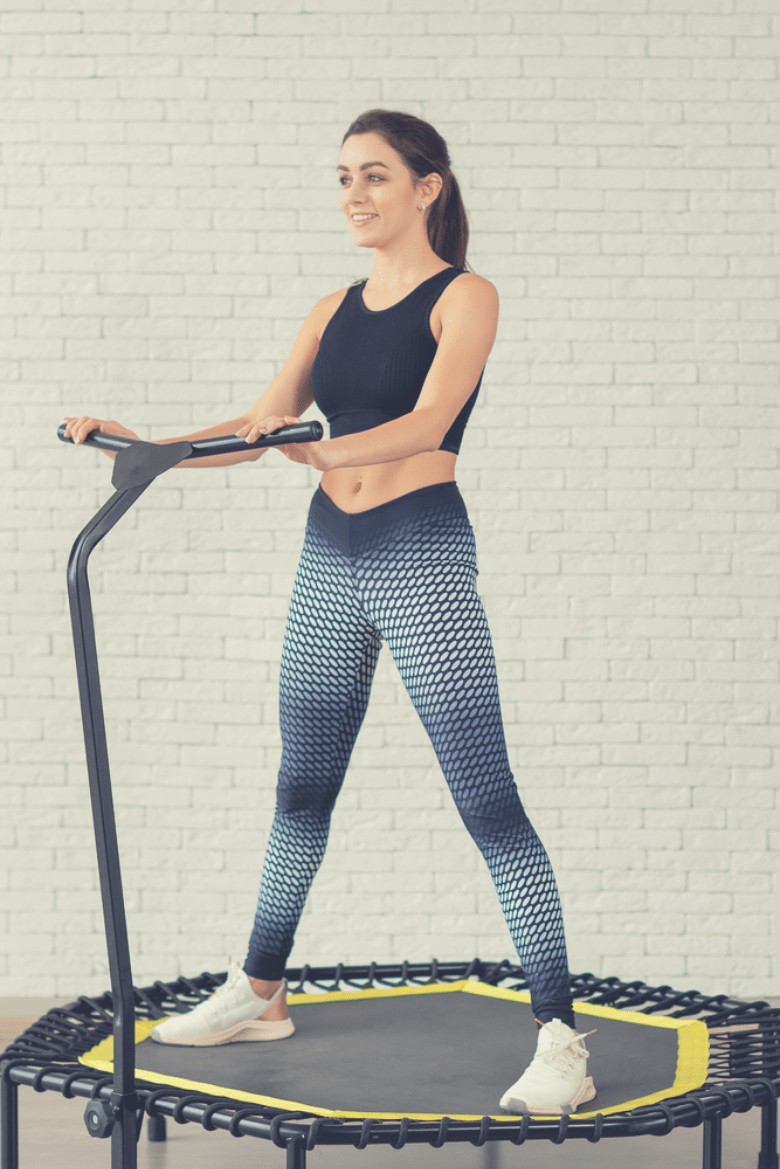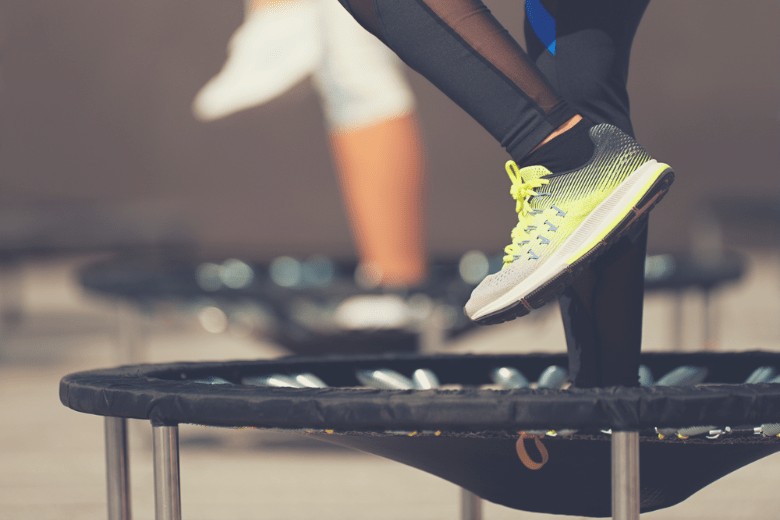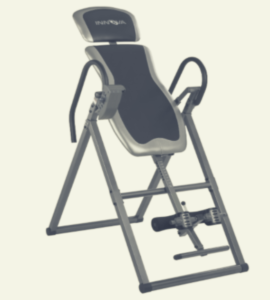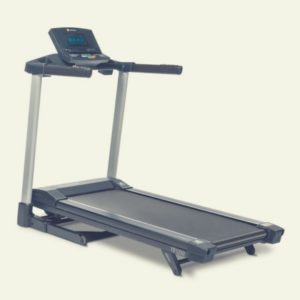I was terribly out of shape and feeling shame every time I passed a gym or saw someone out jogging.
This was something I had to address because I was starting to run the risk of blood pressure and respiratory problems.
Fortunately, I learned about cardio exercises on a trampoline, otherwise known as rebounding.
What is Rebounding?
Rebounding is simply an aerobic workout performed while jumping on a trampoline.
Jumps can be slow or fast.
They can be mixed with aerobic stepping or rest.
Rebounding is popular and growing ever more so because it is gentle on your joints while working your cardiovascular system.
Essentially, it is great low impact cardio without overly taxing your body.
Why Try Rebounding?
This low-impact cardio exercise is generally appropriate for you regardless of your age.
It works the core, deep back, leg, and buttock muscles, helps improve your endurance, assists in improving your motor skills, balance, and coordination, and supports bone strength, density, and formation.
It does this latter while decreasing the resorption of bones, making it a good choice if you have the condition known as osteoporosis.
Rebounding may even give you more bang for your buck when compared to running or jogging.
According to NASA, a study showed that exercising by jumping on a trampoline proves more effective at the stimulation of oxygen uptake and heart rate than does jogging. And it does so with less damage to your joints.
Rebounding does all this while burning serious calories, boosting your energy, and sculpting your core, legs, and butt.
Safety Tips for Rebounding
With any exercise regimen, you should start by consulting your doctor. If you have had surgeries or medical concerns, rebounding may not be for you.
Other safety tips include checking that your trampoline is standing on a stable surface, that your trampoline is in good working order, and that it is away from your walls and furniture.
Staying Safe While You Move
While using your trampoline, switch up the types of moves you do.
Do not overuse the same sets of muscles every time you jump.
Consider a handlebar for your trampoline to add stability and aid balance.
Cease jumping at once if you notice pain, unusual shortness of breath, or other health-related warning signs.
Equipment for Safety
While shoes are optional when rebounding, they can offer more support.
When you bounce with bare feet, it places more strain upon your lower limbs and feet while attempting to stabilize on the soft surface of the mat.
You should consider wearing a medium-weight sneaker that offers good ankle support.
This is perfect so you can focus on working your abs, glutes, and hamstrings as opposed to your lower limbs.
Choosing a Trampoline
Rebounding is best done on a small, indoor trampoline often referred to as a mini-trampoline.
If you are short on space, try a foldable model to easily stow it away when you are not using it.
When small children are in the house, be sure to take care of your trampoline. This will avoid injuries.
Select a model that has stable, sturdy legs. You will find the circumferences range from three to four feet. It should be capable of supporting an adult’s full weight.
Larger trampolines support heavier weights. Seek a model that has quiet performance so the springs are silent when you bounce.
Selecting Accessories

Some accessories will help you to get the most out of your rebounding exercises. In particular, handlebars and resistance bands will give your workout a helping hand.
Handlebars
Try a handlebar for security, stability, and versatility.
Some are bolt-on, others have quick-release attachments.
This accessory increases safety, helps to build your confidence in your movements, and has a robust design allowing for bodyweight exercises.
Barre workouts become possible with handlebars, and they are adjustable in height for tall or short users.
Resistance Bands
A resistance band adds an extra aspect of muscle toning to any trampoline workout.
Such bands improve control by way of strengthening your core, adjusting your posture, and helping to boost your stamina.
Bands enhance your control.
They excel in strength training, Pilates, and physical therapy.
Resistance bands also sculpt and tone the core and upper body.
Base and Assembly
A reliable base is essential if you want to avoid a trampoline accident injury.
The base is what holds the equipment as a whole together. Because it serves as the trampoline’s framework, a rebounder that is poorly framed may increase the risk of breakage.
This can cause accidents. Obviously, then the fun stops.
Two options exist for rebounder frameworks: plastic and steel.
Reviewers and experts alike tend to tout the better support offered by steel frames.
Still, not all steel frames are equal in creation.
To ensure the proper pick, do research about the assembly process.
Avoid units that have screw-in legs; these bear disadvantages and risks such as wearing down over time, screws loosening during storage, and overall questionable stability support.
Find snap-in legs instead.
Springs
Just as important as the base is the quality of the trampoline’s springs.
Tube springs can be risky safety-wise because tube springs can limit your movement as you rebound.
Another spring type is the bungee cord. Unfortunately, these cords may lack proper support, leading to dangerous landings.
Bungee cords also have a sluggish bounce responding time and can wear down as time passes.
Ideally, use a trampoline that has tapered steel springs. This type excels in durability and can endure large movements.
Mat
For safety and efficiency, the mat’s quality also matters.
Your mat may be made of canvas, nylon, or plastics.
Some tend to stretch as time passes, risking the support capability of the mat.
There is also the possibility of the feet going through the surface in that instance.
Prioritize a mat that does not stretch.
Choose one that provides comfort and support, even when you go through your rebounding exercises with bare feet.
Size and Weight
Together, these two aspects add up to how portable and easy to store a mini trampoline is.
If you plan to take your rebounder to classes or to the office to sneak in a bit of exercise between tasks, you will want one that is lightweight and easy to carry.
Some are foldable for ease of storage and transport.
10 Trampoline Workout Ideas For Burning Calories
Rebounding may seem simple, but some workouts can be challenging to follow in the beginning.
Remember that, unlike when jumping on a trampoline for sheer pleasure, you want to avoid high jumps when working out.
Another key aspect to keep in mind is how to jump.
Remember that you bounce down and inward into the trampoline.
At first, everyone tries jumping up as they would on a trampoline for recreation, but the secret to good trampoline workouts lies in the downward motion.
Do this by pressing the heels with a softening in the knees.
Think about pulling up your knees toward your chest using your low abs.
Keep legs pumping with a low torso.
Warm-up
Begin by jumping easily for a few minutes to warm up the necessary muscle groups.
The idea, in the beginning, is to get used to the jumping sensation.
This is not an everyday activity for most people. And the proper jumping method is not, generally, what you would naturally do.
Instead, as mentioned, you want to try stomping down on the surface of the trampoline. You do not need a particularly high jump; one to two inches suffices.
Basic Jog
A basic trampoline jog is a great beginning exercise.
This involves either a straight back or, alternatively, keeping a slight backward lean while lifting your knees up before you as you are jogging in place.
Just as when you run on the ground, pump your arms at your sides.
Bounce Down
This trampoline workout involves standing in the center of your trampoline.
Stand with your feet a little wider than the distance of your hips.
Seek to maintain the height of your head at one level while jumping, tucking your knees up to your chest.
Ensure that you are springing off with your entire foot, not only using your heels or your toes.
Land back.
Swing your arms in opposition for the purpose of counterbalancing.
Continue this for two minutes.
Jumping Jacks
An old favorite with a slight adaptation, this move becomes more impactful on a trampoline.
Start with your feet under your hips in the center of your trampoline.
Jump, moving your legs out so your feet land outside the width of your shoulders, moving your arms to extend to either side.
Then hop your feet together, crossing your arms before your chest.
Try keeping your head at the same height by focusing your bounces downward rather than up. Continue this for two minutes.
Scissors
Begin with your feet beneath your hips in the center of your trampoline.
In one motion, hop one foot forward and the other foot back; land with a slight bend in your knees, keeping your hips square.
Swiftly reverse the position of your legs, swinging your arms back and forth to produce extra momentum. Continue this motion for two minutes.
Ski
For this move, begin with your feet set wider than your shoulders.
Here is the tricky part.
While facing your torso forward, jump so your feet land together on on side of the trampoline.
While you do this, swivel your lower body so that your knees, hips, and feet are facing toward the trampoline’s opposite front corner.
Swiftly reverse this movement with a bound to the trampoline’s other side.
Keeping your elbows bent, swing your arms before you with elbows bent for bonus power.
Keep on with the ski maneuver for two minutes.
Surf Twist
Start, and maintain throughout this trampoline workout, your feet at the width of your shoulders.
Bounce downward while rotating your body 1/4th turn in one direction. Use the rebound moment to return to your starting position.
Then repeat in the same direction. Do not switch directions until you have moved in the first direction twice.
Then switch to the other direction. Continue, switching sides after each pair of twists, while swinging your arms in opposition of your body to serve as a counterbalance.
Do this for two minutes.
Front Back
Begin at rest, standing in the center of the trampoline with your feet under your hips and your hands at your sides.
Then tuck your knees and hop forward and back on the trampoline.
Do this while maintaining square hips and shoulders.
For counterbalance, swing your arms in the opposite direction of your legs.
Try, as generally is the case, to keep your head at the same height throughout.
Do this by bouncing with a downward focus. Carry on with this motion for two minutes.
Cross Kick
This time, start with your feet slightly further apart than your hips.
Keep your shoulders straight and forward as you rotate your hips to the left side while kicking your right leg across your body.
This is where the movement gets its name.
Maintain a very slight bend in the standing leg throughout. For counterbalance, swing your arms down toward your left side.
Do this, without switching sides, for one minute. Once the minute is up, then switch sides for the second minute of this trampoline workout move.
Knee Pull
Start with your feet positioned under your hips.
Extend your arms before you at shoulder height.
Then pull your arms back while you lift a knee toward your chest, maintaining a 90-degree bend in that leg.
Return the leg to start, repeating on the same side for a single minute.
For the second minute, switch sides.
Final Thoughts

Using a trampoline has changed my life. I hated jogging and running, but now I have a means of exercise in my own home that gives me a NASA-proven better workout.
I get my heart rate up and my sweat flowing without the stress on my body from pounding on pavement.
A trampoline workout can offer amazing cardio benefits, and by performing these 10 exercises, you can reap the rewards, too.



